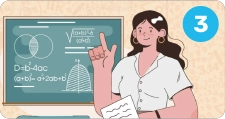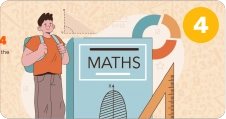Update: This article was last updated on 24th February 2025 to reflect the accuracy and up-to-date information on the page.
Has long multiplication ever stumped you? Now imagine doing it in seconds as well as not using a calculator! Vedic Maths present some techniques-simple but very powerful-and here today we have one of it-Yavadunam.
The famous and amazing ancient Indian math tricks are Vedic Mathematics, which are very different and productive ways to do all types of mathematics. One of these is Yavadunam sutra, which presents a very novel method of multiplication. The words “saved“, which means “as much as” and “dunam“, which means “the product“, are derived from Sanskrit. This sutra proves to be a very easy way of multiplying numbers very close to a common base.
This blog will discuss the Yavadunam sutra and how it can be used to improve multiplication skills in children.
Learn The Yavadunam Sutra
“You reduce it further and further as far as inference from the deficiency, and then establish the square of the deficiency in that manner.” Thus is defined the Yavadunam Sutra. It looks complicated but can be actually broken into a very easy staircase kind of approach to multiplying.
Step 1: Identify a suitable base
The number must be a base number close to both multiplicand and multiplier. Because the bases do not differ from the actual values, these steps are made simpler.
Step 2: Find out the deficiencies
Get the deficiencies of the multiplicand and the multiplier w.r.t the chosen base. So the deficiency is the difference of the number and base in numericals.
Step 3: Adjust the numbers
The new numbers are far easier to work with; subtract deficiencies from base, the numbers will adjust.
Step 4: Multiply the adjusted numbers
Multiply the final numbers derived from the previous step.
Step 5: Account for the deficiency of the base
Square it for the deficiency of base and subtract it from the product achieved in the earlier step.
Step 6: Determine the final result
This is the product of the original multiplicand and multiplier because the difference square was taken away from it.
Let’s now see a few examples:
Example 1
162 = (16+6)/62 = 22/36 = 256
So in the above problem, 16 is 6 more than 10(Base 10), So Excess = 6
Increase it still further to that extent, So (16+6) = 22
Square it’s excessive, So 62 = 36
Final Answer: 256
Example 2
922 = (92-8)/82 = 84/64 = 8464
So in the above problem, 92 is 8 less than 100(Base 100), So deficiency = 8
Reduce it further to that extent, So (92-8) = 84
Square its deficiency, So 82 = 64
Final Answer: 8464
Common Mistakes and How to Avoid Them
While the powerful yet yavadunam sutra for square proves beginner mistakes while applying it, here are some common mistakes and solutions to avoid them:
1. Choosing Wrong Base
- The yavadunam sutra for squares applies very well when we choose a base that is close to the number whose square we have to take.
- In case the base is farther from the original number, then calculation may involve becoming complicated rather than simpler.
- Tip: Always choose a base that makes the deficiency small and manageable.
2. Wrongly Calculating the Deficiency
- The deficiency is a difference of truth and base, and the wrong set of deficiency leads to the wrong answer.
- Example Mistake: Importantly, if some person does not take it into account that 92 has a deficiency of 9 instead of 8 when the base is 100, calculations run far.
- Tip: Double-check the deficiency before proceeding with the steps of the yavadunam sutra for squares.
3. Incorrectly Squaring the Deficiency
- Some learners forget to square the deficiency or make calculation errors while squaring.
- Example: Squaring 7 but writing it as 14 instead of 49 will give you an incorrect final answer.
- Tip: Always verify your squared value and ensure it follows the proper placement in the equation.
By avoiding these mistakes, students can smoothly apply the yavadunam sutra for squares and make their multiplication action much faster.
Wrapping Up!!
Vedic maths is an awesome science and has many more tips apart from the Yavadunam sutra. Tricks like these make students more adept at doing mental calculations; hence they find maths a more fascinating subject to learn.
Also, Moonpreneur is dedicated to making children well-versed in every possible concept of STEM-related subjects, and in this avid commitment, we have started the program MoonMath, where a child learns the concepts of Vedic Maths, Advanced Mathematics, and Mental Math.
Enroll Today in our free Advanced Math workshop or call our program advisor at +1 (855) 550-0571.


















What is the main principle behind Vedic Mathematics?
Vedic Mathematics is based on ancient Indian sutras, offering concise formulas for efficient mental calculations and emphasizing the interconnectedness of mathematical operations.
Can you tell me why is vedic math accurate?
Vedic Mathematics is accurate for some in mental calculations, but preferences vary based on context and application.